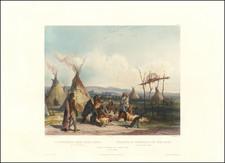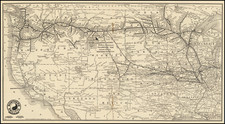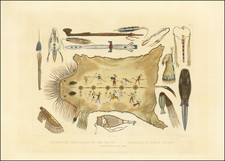Fort Clark. On the Missouri (February 1834) is a compelling aquatint by Swiss artist Karl Bodmer that offers an evocative glimpse into the life and landscape of the American frontier during the winter of 1833-34. This artwork represents the culmination of Bodmer's five-month stay at Fort Clark, where he bore witness to the severe winter conditions and daily activities of the Mandan tribe who dwelled nearby.
Bodmer's sojourn at Fort Clark, situated on the Missouri River in present-day North Dakota, was a time of significant transition for Native American tribes such as the Mandan. Exemplifying this adaptation, Bodmer's work presents a stark, yet animated, mid-winter scene, where the frozen landscape is brought to life by the constant flux of figures moving across the ice. The fort itself is visible in the mid-distance, juxtaposed with the Mandan women in the foreground, laden with their burdens, wrapped warmly in buffalo robes and proceeding past watchful warriors.
Bodmer's depiction pays particular attention to the tribal dynamics of the period. Amidst the escalating pressures of neighboring tribe raids, the Mandan people had consolidated their population into two main villages: Mih-Tutta-Hang-Kusch and Ruhptare. The former, the larger of the two, is discernible in the distance across the Missouri, adding an additional layer of socio-cultural context to the painting.
Fort Clark. On the Missouri (February 1834) stands as a testament to Bodmer's meticulous observations of frontier life, and it provides a compelling portrayal of resilience in the face of nature's harshness and the precarious socio-political climate of the time. This painting is a salient document of the artist's travel and engagement with the indigenous people of North America, lending invaluable insights into their history and culture.
State
Ruud's first (of 3) states, without the date (February 1th 1841) added.










![[Upper Missouri River, Lake Winnipeg, Lake of the Woods and Skatehawan River] Amer. Sep. No. 33. Partie De La Nouvelle Bretagne](https://storage.googleapis.com/raremaps/img/small/80101.jpg)
![(Mexican-Aztec Paintings) [Original watercolor of Aztec Deities: Panquetzaliztli, Atemoztli, Nemontemi, and others]](https://storage.googleapis.com/raremaps/img/small/103006.jpg)

![[Red River Valley] Map of the Wheat Region Red River Valley and adjoining Countries in Dakota and Minnesota Published by A.J. Harwood, Fargo, D.T.](https://storage.googleapis.com/raremaps/img/small/70591.jpg)
